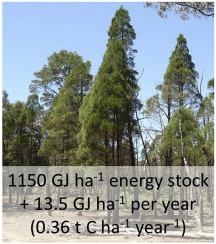Biomass & Bioenergy ( IF 5.8 ) Pub Date : 2020-07-10 , DOI: 10.1016/j.biombioe.2020.105656 Mathias Neumann , Chris Eastaugh , Mark Adams

|
Contributions of forests to meeting worldwide energy demand vary depending on management systems, growth conditions and legal and environmental constraints. Many countries rich in forest resources - including Australia - utilize those resources only sparingly owing to poor understanding of their sustainability. Semi-arid woodlands dominated by Callitris and Eucalyptus spp. are common in inland Australia but are slow growing. There is little published information on wood properties (including basic density, carbon concentration, energy) for this forest type. We estimated the carbon and energy stocks of mixed Callitris stands in central-eastern Australia, linking laboratory analysis with field sampling and surveys. Wood density of Callitris spp. was 30% less than that of admixed Eucalyptus spp. Carbon and energy densities of Callitris spp. were also less than admixed species, albeit with reduced variation. While Eucalyptus spp. constitute about 40% of the growing stock, and have mostly larger dimensions, they are not generally harvested due to regulatory constraints and limited markets for their wood products. Based on conservative rates of growth, harvested biomass would provide ~4000 kWh ha−1 year−1. If used with cogeneration technology, biomass fuel could assist in balancing seasonal energy demands, especially for heating and cooling. While slow-growing, Callitris-Eucalyptus forests share many features with other economically relevant species and forests worldwide. Quantification of potential bioenergy is a crucial first step in optimizing forest management and addressing the market constraints and infrastructure needs of any potential biofuel project.
中文翻译:

在澳大利亚中东部管理Callitris-Eucalyptus混交林的碳和能源
森林对满足全球能源需求的贡献取决于管理系统,生长条件以及法律和环境限制。许多森林资源丰富的国家(包括澳大利亚)仅由于对可持续性的了解不足而很少使用这些资源。半干旱林地以Callitris和Eucalyptus spp为主。在澳大利亚内陆很常见,但生长缓慢。关于这种森林类型的木材特性(包括基本密度,碳浓度,能量)的公开信息很少。我们将实验室分析与现场采样和调查联系起来,估算了澳大利亚中东部混合Callitris林的碳和能源储量。愈伤组织的木材密度spp。比混合桉树少30%。Callitris spp。的碳和能量密度。尽管变异减少,但它们也比混合物种少。而桉树属。占约40%的不断增长的种群,并且大多具有较大的尺寸,由于监管限制和木材产品市场有限,通常不进行采伐。根据保守的增长率,收获的生物量将提供约4000 kWh公顷- 1年-1。如果与热电联产技术一起使用,则生物质燃料可以帮助平衡季节性能源需求,尤其是在供热和制冷方面。尽管生长缓慢,但Callitris-Eucalyptus森林与全球其他与经济相关的物种和森林具有许多共同特征。潜在生物能源的量化是优化森林管理,解决任何潜在生物燃料项目的市场限制和基础设施需求的关键的第一步。











































 京公网安备 11010802027423号
京公网安备 11010802027423号